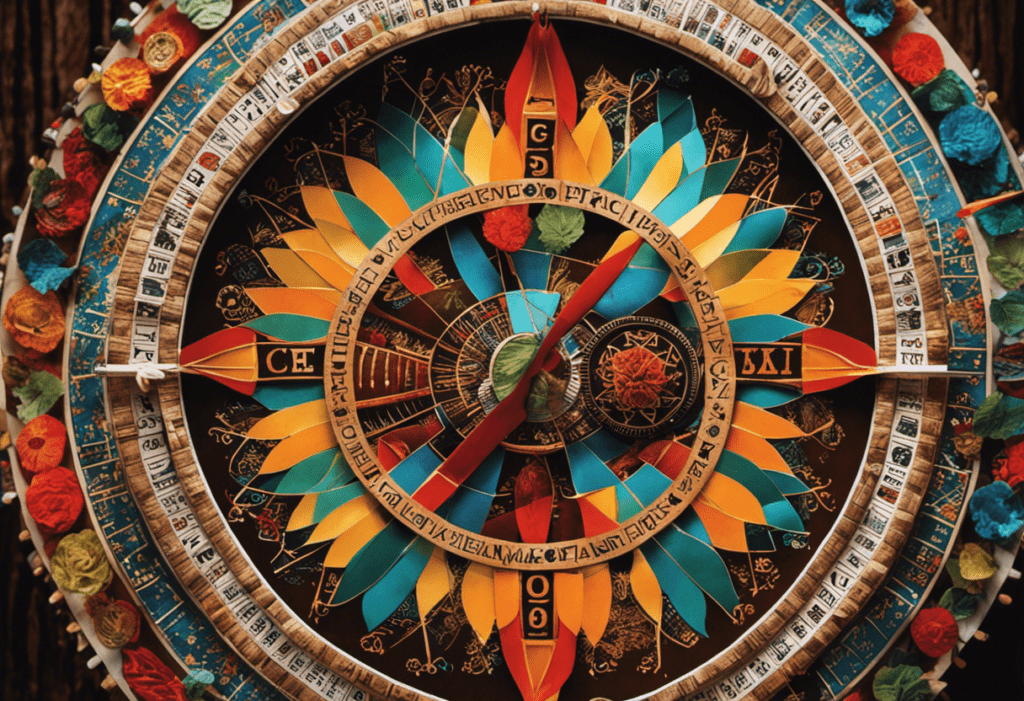Have you ever wondered how ancient cultures measured time and celebrated the passing of seasons?
In this article, we will explore the depths of the Cherokee calendar, a rich and symbolic system that encompasses the circle of life, the changing seasons, and the concept of time.
Through an objective and analytical lens, we will delve into the significance of this calendar in Cherokee culture, its influence on daily life and decision making, and the sacred rituals and festivals that accompany it.
Key Takeaways
- The circle represents the cyclical nature of time and the interconnectedness of all living beings.
- The Cherokee Calendar guides agricultural practices and aligns them with the natural rhythms of the earth for sustainable farming.
- The calendar reflects a deep connection to ancestors, with specific ceremonies and rituals conducted to honor and remember them.
- Time in Cherokee culture is perceived as a symbol of the eternal cycle of life, reminding the Cherokee people of their place within the larger cycles of life and honoring the wisdom and guidance provided by nature and ancestors.
The Significance of the Circle of Life in the Cherokee Calendar


The understanding of the circle of life plays a crucial role in the interpretation and significance of the Cherokee calendar. The cycle of life in Cherokee culture is deeply intertwined with their spiritual beliefs and practices. The Cherokee people view life as a continuous circle, with no clear beginning or end. This concept is reflected in their calendar, which is based on the natural cycles of the seasons and the movement of celestial bodies.
In Cherokee culture, the circle of life represents the interconnectedness of all living things. It symbolizes the eternal cycle of birth, growth, death, and rebirth. The Cherokee calendar reflects this spiritual meaning by dividing the year into 13 moons, each representing a different aspect of life. These moons are named after natural phenomena or events that occur during that time, such as the planting moon or the harvest moon.
The Cherokee calendar also incorporates the concept of time as a cyclical process. Instead of linear time, where events occur in a straight line from past to present to future, the Cherokee calendar recognizes that time is circular and repeats itself. This understanding of time is reflected in the annual rituals and ceremonies that the Cherokee people perform, which are based on the cycles of nature and the changing seasons.
Overall, the circle of life holds great significance in the Cherokee calendar. It represents the spiritual beliefs and practices of the Cherokee people, highlighting their deep connection to the natural world and their understanding of the cyclical nature of life.
Understanding the Seasons in the Cherokee Calendar


A thorough comprehension of the cyclical patterns within the indigenous calendar system allows for a deeper understanding of the natural shifts in climate and environmental conditions. In the Cherokee calendar, the changing of seasons is a fundamental aspect that guides their seasonal traditions and agricultural practices.
The Cherokee calendar recognizes four main seasons: spring, summer, fall, and winter. Each season has its own distinct characteristics and is marked by specific celestial and natural events.
Spring is a time of renewal and fertility, symbolized by the blooming of flowers and the return of migratory birds. It is a time for planting crops and preparing the earth for the upcoming growing season.
Summer is associated with warmth and abundance. The days are longer, and the crops begin to ripen. It is a time for harvesting and preserving the bountiful yields.
Fall, also known as the harvest season, is characterized by cooler temperatures and the changing colors of leaves. It is a time for gathering the final harvest and storing food for the winter.
Winter is a period of rest and reflection. It is a time to conserve resources and rely on stored food. Winter ceremonies and storytelling become prominent during this season.
The Cherokee people’s seasonal traditions and agricultural practices are deeply intertwined with the natural rhythms of the calendar. Understanding these patterns allows for the effective management of resources and the preservation of their cultural heritage.
The Sacred Rituals and Festivals of the Cherokee Calendar


Sacred rituals and festivals held within this indigenous calendar system serve as important cultural events that honor celestial and natural occurrences. The Cherokee people have a deep connection to their calendar, which is based on the cycles of the moon and the changing of the seasons. These sacred rituals and festivals are an integral part of their spiritual and cultural identity.
One of the most significant festivals in the Cherokee calendar is the Green Corn Ceremony, also known as the New Year Festival. This festival marks the beginning of the agricultural year and is a time for purification and renewal. It is a time when the community comes together to give thanks for the harvest and to pray for a bountiful year ahead.
Another important festival is the Fall Festival, which celebrates the harvest and gives thanks for the abundance of the season. During this festival, the Cherokee people gather to share food, dance, and engage in various cultural activities.
To give a clearer picture of the sacred rituals and festivals in the Cherokee calendar, the following table provides a summary of some of these important events:
| Festival | Purpose |
|---|---|
| Green Corn Ceremony | Mark the beginning of the agricultural year |
| Fall Festival | Celebrate the harvest and give thanks |
| Spring Festival | Welcome the arrival of spring |
| Winter Solstice | Honor the shortest day of the year |
These sacred rituals and festivals are a testament to the deep connection the Cherokee people have with their calendar and the natural world. They serve as important cultural events that not only celebrate the changing of the seasons but also reinforce the spiritual beliefs and values of the community.
Exploring the Symbolism of Time in the Cherokee Culture


Symbolism in the perception of time plays a significant role within the cultural practices and beliefs of the Cherokee people. Time is not seen as linear but rather as cyclical, with each season and cycle representing different aspects of life and nature. This symbolism is deeply ingrained in the Cherokee culture and holds great cultural significance.
The Four Directions: The Cherokee people believe that time is divided into four directions – north, south, east, and west. These directions represent different stages of life and are associated with different seasons, animals, and elements. They are seen as guides and sources of wisdom.
The Medicine Wheel: The Medicine Wheel is a spiritual symbol that represents the circle of life and the interconnectedness of all things. It is divided into four quadrants, each corresponding to a different season, element, and stage of life. The Medicine Wheel is used in ceremonies and rituals to honor the cycles of time.
The Sacred Fire: Fire is a powerful symbol in Cherokee culture, representing purification, transformation, and renewal. The Sacred Fire is lit during important ceremonies and festivals, symbolizing the passage of time and the eternal cycle of life.
The Circle: The circle is a universal symbol of eternity and unity. In Cherokee culture, the circle represents the cyclical nature of time and the interconnectedness of all living beings. It is seen as a reminder of the importance of balance and harmony in life.
The symbolism of time in Cherokee culture reflects a deep understanding and respect for the natural world and the interconnectedness of all things. It serves to remind the Cherokee people of their place within the larger cycles of life and to honor the wisdom and guidance provided by nature and the ancestors.
How the Cherokee Calendar Influences Daily Life and Decision Making


The influence of the Cherokee calendar on daily life and decision making is evident in the way that time is perceived and honored within the culture. The calendar not only serves as a means to mark the passage of time but also holds significant importance in guiding agricultural practices and maintaining a connection to ancestors.
In terms of agriculture, the Cherokee calendar plays a crucial role in determining the appropriate times for planting, harvesting, and other agricultural activities. The calendar is based on the observation of celestial events, such as the solstices and equinoxes, which signal the changing seasons. This knowledge allows the Cherokee people to align their agricultural activities with the natural rhythms of the earth, maximizing their chances of a successful harvest. The calendar serves as a guide, ensuring that the right crops are planted at the right time and providing a framework for sustainable farming practices.
Additionally, the Cherokee calendar reflects a deep connection to ancestors. It is believed that the spirits of the ancestors are present and guide daily life. The calendar serves as a way to honor and remember them, with specific ceremonies and rituals conducted at key times throughout the year. This connection to ancestors strengthens the cultural identity of the Cherokee people, reminding them of their heritage and the wisdom passed down through generations.
Conclusion
In conclusion, the Cherokee calendar holds immense significance in their culture, representing the circle of life, the changing seasons, and the passage of time.
The calendar is not just a tool for tracking days, but a guide for sacred rituals and festivals that shape their daily lives.
By understanding the symbolism and teachings within the calendar, the Cherokee people make informed decisions and maintain a strong connection to their cultural heritage.
As the saying goes, ‘The Cherokee calendar reminds us of the timeless wisdom passed down through generations.’




